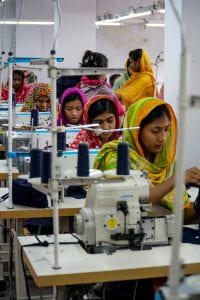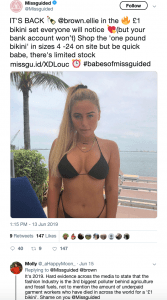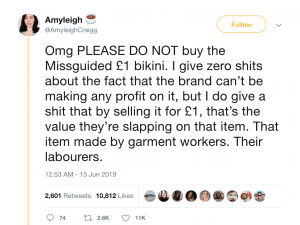[ Bonus video! At the bottom of my post, you’ll find a funnier take on this serious subject in a video about fast fashion from Last Week Tonight with John Oliver. It’s 17 min long, but worth it.]

My last blog post featured a video outlining fast fashion’s negative global impact. In this post, I’m exploring the unethical labor practices at the root of fast fashion manufacturing and the ‘hidden’ human beings at the other end of the apparel supply chain.
In his TEDx Talk, Patrick Woodyard, CEO of sustainable shoe and accessories brand Nisolo, made the apt point:
As the distance from the production location to the purchase location of our products has grown, what has decreased is the amount of accountability and transparency in our supply chain.
Today, we are so far removed from the people who make our clothing, shoes, and accessories. Most consumers don’t think about the point of origin of the items in their closet, or the skilled garment workers who created them. It’s certainly easier to let all the ethical issues in the global clothing supply chain stay out-of-sight, out-of-mind.
In a world with social media and the internet, we are increasingly informed; we’re becoming more conscientious about the brands we choose to support. This is where ethical fashion enters the equation:
“Ethical fashion refers to clothing and apparel produced by manufacturers that aim to reduce waste and exploitation in their supply chain wherever possible.”
In pursuit of cheaper manufacturing costs, many major fashion brands are moving apparel production to underdeveloped parts of the world where workers earn far less, like Cambodia, India, and Bangladesh (one of the very worst offenders in the treatment of garment workers), and exploitation goes unchecked. Despite labor laws that may be in place, lack of oversight by local government and outside agencies in rural or developing areas frequently results in exploitation and human rights violations.
Fast Fashion’s Unethical Labor Practices
◇ Garment industry workers are paid below-living wages, or below minimum wages, which are not living wages
-
- Most factory workers earn less than $2 per day, with no way to save for sickness or emergencies
- Workers report if they ask for better wages they’re told the work will go to someone else
- ‘Flexible’ or no contracts for workers, and those with contracts are often threatened with losing them if they don’t meet production quotas or deadlines
- Self-employed homeworkers are even further exploited; women and girls doing garment work from home are sub-contracted by factories on a per-piece basis that pays even less than factory work, for example in India, they earn between $0.13 and $0.15 per hour while also having to absorb some production costs
- It’s estimated that about 60% of garment production is done by primarily female homeworkers in Asia and Latin America
◇ Child labor is rampant
-
- Factories in rural areas will hire anyone able to work, either in the factory or subcontracted as a homeworker
- These children are underprivileged, living in extreme poverty, and denied an education, keeping them in the cycle of poverty as adults
◇ Major health & safety risks exist due to substandard working conditions in factories
-
- Safety standards and requirements are completely disregarded
- Shoddy, unsafe construction is used to build these factories inexpensively and speedily
- According to one study, the occurrence of serious injuries and disabilities almost doubles among individuals with factory jobs (7%), as opposed to non-factory jobs (4%). This risk percentage increases every month a worker remains employed in the factory.
- Unsafe working conditions that continued unchecked resulted in the collapse of Rana Plaza in 2013, an 8-story building that housed 5 factories and thousands of workers. About 1,134 workers tragically died in the building collapse, and over 2,000 were injured; it was a wake-up call for many Americans when brands such as Gap and The Children’s Place were found to have clothing manufactured in these factories
◇ Management practices are often illegal and abusive
-
- In a mostly-female workforce, women in garment factories endure daily sexual harassment, intimidation, and workplace violence, including physical and sexual abuse, carried out by the all-male management, supervisors, and male co-workers
- Factory owners and managers often fire pregnant women or deny them their right to maternity leave
- Workers that join or form labor unions face retaliation (ex: horrific physical beatings) despite the fact that unions are protected by law
Wow. Some of the facts about unethical labor practices are hard to read, and becoming a more conscious fashion consumer is really difficult. Change is uncomfortable. But we’re in an era of major thought-change, so let’s challenge ourselves to start thinking about fashion differently, too. Let’s remember the stories of the women at the opposite end of the fashion supply chain and get concerned (like the Twitter user below) about deals that seem too good to be true–like this bikini for £1 ($1.26):


In the next post, I’ll tell you about some simple steps you can take to become a little more ethical and sustainable with your fashion choices. (HINT: It won’t involve throwing all your clothes away and starting over. 😉)
Please feel free to comment and ask questions, I’d love to know what you think. What surprised you the most? Are you interested in outgrowing fast fashion?
Thank you for reading, and enjoy a little of John Oliver’s fast fashion-outrage below! 👇
Stylishly Yours,
Molly
And now, this:
View my sources below. Click the links to if you’d like to read more about ethical labor practices.
Resources:
Blattman, C., & Dercon, S. (2017, April 27). Everything We Knew About Sweatshops Was Wrong. Retrieved from https://www.nytimes.com/2017/04/27/opinion/do-sweatshops-lift-workers-out-of-poverty.html
Epatko, L. (2018, April 6). 5 years after the world’s largest garment factory collapse, is safety in Bangladesh any better? Retrieved from https://www.pbs.org/newshour/world/5-years-after-the-worlds-largest-garment-factory-collapse-is-safety-in-bangladesh-any-better
Fast Fashion’s Effect on People, The Planet, & You | Patrick Woodyard | TEDx University of Mississippi. (2017, March 8). Retrieved from https://www.youtube.com/watch?v=mPM9lhackHw&feature=share
Fashion: Last Week Tonight with John Oliver (HBO). (2015, April 26). Retrieved from https://youtu.be/VdLf4fihP78
Findlay, O. (2019, June 20). People are not happy about that £1 Missguided bikini. Retrieved from https://www.glamourmagazine.co.uk/article/missguided-bikini-backlash?utm_term=Autofeed&utm_medium=Social&utm_source=Twitter#Echobox=1561800394
Hodal, K. (2018, June 5). Abuse is daily reality for female garment workers for Gap and H&M, says report. Retrieved from https://www.theguardian.com/global-development/2018/jun/05/female-garment-workers-gap-hm-south-asia
Kara, S. (2019, February 15). The invisible women and girls who make your clothes. Retrieved from https://www.eco-business.com/opinion/the-invisible-women-and-girls-who-make-your-clothes/
Labour Behind the Label. (n.d.). Working Conditions. Retrieved 20 September 2019 from http://labourbehindthelabel.org/our-work/working-conditions/
Martin-Muir, F. (2019, April 9). Why ethical fashion is made for referral marketing: Buyapowa’s Expert Insight on Referral Marketing: Blog. Retrieved from https://www.buyapowa.com/blog/ethical-fashion-made-for-referral-marketing/
Muscati, S. (2018, February 22). Garment Worker Diaries Reveal Working Conditions, Wages in Bangladesh, India, Cambodia. Retrieved from https://sustainablebrands.com/read/marketing-and-comms/garment-worker-diaries-reveal-working-conditions-wages-in-bangladesh-india-cambodia
Stauffer, B. (2018, April 6). World Report 2018: Rights Trends in “Soon There Won’t Be Much to Hide”. Retrieved from https://www.hrw.org/world-report/2018/essay/transparency-in-apparel-industry
WIEGO. (n.d.). Garment Workers. Retrieved 20 September 2019 from https://www.wiego.org/informal-economy/occupational-groups/garment-workers


